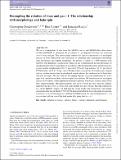Files in this item
Decoupling the rotation of stars and gas - I. The relationship with morphology and halo spin
Item metadata
| dc.contributor.author | Duckworth, Christopher | |
| dc.contributor.author | Tojeiro, Rita | |
| dc.contributor.author | Kraljic, Katarina | |
| dc.date.accessioned | 2020-02-17T17:30:02Z | |
| dc.date.available | 2020-02-17T17:30:02Z | |
| dc.date.issued | 2020-02 | |
| dc.identifier | 266327745 | |
| dc.identifier | dc0f1edb-0224-4d21-9313-63b46b7c6d46 | |
| dc.identifier | 85082705657 | |
| dc.identifier | 000512297600025 | |
| dc.identifier.citation | Duckworth , C , Tojeiro , R & Kraljic , K 2020 , ' Decoupling the rotation of stars and gas - I. The relationship with morphology and halo spin ' , Monthly Notices of the Royal Astronomical Society , vol. 492 , no. 2 , pp. 1869-1886 . https://doi.org/10.1093/mnras/stz3575 | en |
| dc.identifier.issn | 0035-8711 | |
| dc.identifier.other | BibCode: 2020MNRAS.492.1869D | |
| dc.identifier.uri | https://hdl.handle.net/10023/19484 | |
| dc.description | Funding: UK Science and Technology Funding Council (STFC) via an PhD studentship (grant number ST/N504427/1). | en |
| dc.description.abstract | We use a combination of data from the MaNGA survey and MaNGA-like observations in IllustrisTNG100 to determine the prevalence of misalignment between the rotational axes of stars and gas. This census paper outlines the typical characteristics of misaligned galaxies in both observations and simulations to determine their fundamental relationship with morphology and angular momentum. We present a sample of ˜4500 galaxies from MaNGA with kinematic classifications which we use to demonstrate that the prevalence of misalignment is strongly dependent on morphology. The misaligned fraction sharply increases going to earlier morphologies (28 ± 3 per cent of 301 early-type galaxies, 10 ± 1 per cent of 677 lenticulars, and 5.4 ±0.6 per cent of 1634 pure late-type galaxies). For early-types, aligned galaxies are less massive than the misaligned sample whereas this trend reverses for lenticulars and pure late-types. We also find that decoupling depends on group membership for early-types with centrals more likely to be decoupled than satellites. We demonstrate that misaligned galaxies have similar stellar angular momentum to galaxies without gas rotation, much lower than aligned galaxies. Misaligned galaxies also have a lower gas mass than the aligned, indicative that gas loss is a crucial step in decoupling star-gas rotation. Through comparison to a mock MaNGA sample, we find that the strong trends with morphology and angular momentum hold true in IllustrisTNG100. We demonstrate that the lowered angular momentum is, however, not a transient property and that the likelihood of star-gas misalignment at z= 0 is correlated with the spin of the dark matter halo going back to z= 1. | |
| dc.format.extent | 6676582 | |
| dc.language.iso | eng | |
| dc.relation.ispartof | Monthly Notices of the Royal Astronomical Society | en |
| dc.subject | Galaxies: evolution | en |
| dc.subject | Galaxies: haloes | en |
| dc.subject | Galaxies: kinematics and dynamics | en |
| dc.subject | QB Astronomy | en |
| dc.subject | QC Physics | en |
| dc.subject | DAS | en |
| dc.subject.lcc | QB | en |
| dc.subject.lcc | QC | en |
| dc.title | Decoupling the rotation of stars and gas - I. The relationship with morphology and halo spin | en |
| dc.type | Journal article | en |
| dc.contributor.institution | University of St Andrews. School of Physics and Astronomy | en |
| dc.identifier.doi | 10.1093/mnras/stz3575 | |
| dc.description.status | Peer reviewed | en |
| dc.identifier.url | http://adsabs.harvard.edu/abs/2020MNRAS.492.1869D | en |
This item appears in the following Collection(s)
Items in the St Andrews Research Repository are protected by copyright, with all rights reserved, unless otherwise indicated.

